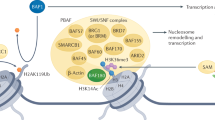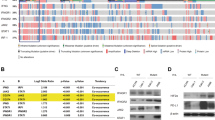Abstract
Upregulation of hypoxia-inducible factors HIF-1 and HIF-2 is frequent in human cancers and may result from tissue hypoxia or genetic mechanisms, in particular the inactivation of the von Hippel–Lindau (VHL) tumour suppressor gene (TSG). Tumours with VHL inactivation are highly vascular, but it is unclear to what extent HIF-dependent and HIF-independent mechanisms account for pVHL tumour suppressor activity. As the identification of novel pVHL targets might provide insights into pVHL tumour suppressor activity, we performed gene expression microarray analysis in VHL-wild-type and VHL-null renal cell carcinoma (RCC) cell lines. We identified 30 differentially regulated pVHL targets (26 of which were ‘novel’) and the results of microarray analysis were confirmed in all 11 novel targets further analysed by real-time RT–PCR or Western blotting. Furthermore, nine of 11 targets were dysregulated in the majority of a series of primary clear cell RCC with VHL inactivation. Three of the nine targets had been identified previously as candidate TSGs (DOC-2/DAB2, CDKN1C and SPARC) and all were upregulated by wild-type pVHL. The significance for pVHL function of two further genes upregulated by wild-type pVHL was initially unclear, but re-expression of GNG4 (G protein gamma-4 subunit/guanine nucleotide-binding protein-4) and MLC2 (myosin light chain) in a RCC cell line suppressed tumour cell growth. pVHL regulation of CDKN1C, SPARC and GNG4 was not mimicked by hypoxia, whereas for six of 11 novel targets analysed (including DOC-2/DAB2 and MLC2) the effects of pVHL inactivation and hypoxia were similar. For GPR56 there was evidence of a tissue-specific hypoxia response. Such a phenomenon might, in part, explain organ-specific tumorigenesis in VHL disease. These provide insights into mechanisms of pVHL tumour suppressor function and identify novel hypoxia-responsive targets that might be implicated in tumorigenesis in both VHL disease and in other cancers with HIF upregulation.
This is a preview of subscription content, access via your institution
Access options
Subscribe to this journal
Receive 50 print issues and online access
$259.00 per year
only $5.18 per issue
Buy this article
- Purchase on Springer Link
- Instant access to full article PDF
Prices may be subject to local taxes which are calculated during checkout



Similar content being viewed by others
References
Agathanggelou A, Bieche I, Ahmed-Choudhury J, Nicke B, Dammann R, Baksh S, Gao B, Minna JD, Downward J, Maher ER and Latif F . (2003). Cancer Res., 63, 5344–5351.
Baba M, Hirai S, Yamada-Okabe H, Hamada K, Tabuchi H, Kobayashi K, Kondo K, Yoshida M, Yamashita A, Kishida T, Nakaigawa N, Nagashima Y, Kubota Y, Yao M and Ohno S . (2003). Oncogene, 22, 2728–2738.
Bornstein P and Sage EH . (2002). Curr. Opin. Cell Biol., 14, 608–616.
Chlenski A, Liu S, Crawford SE, Volpert OV, DeVries GH, Evangelista A, Yang Q, Salwen HR, Farrer R, Bray J and Cohn SL . (2002). Cancer Res., 62, 7357–7363.
Clifford SC, Cockman ME, Smallwood AC, Mole DR, Woodward ER, Maxwell PH, Ratcliffe PJ and Maher ER . (2001). Hum. Mol. Genet., 10, 1029–1038.
Clifford SC, Prowse AH, Affara NA, Buys CH and Maher ER . (1998). Genes Chromosomes Cancer, 22, 200–209.
Cockman ME, Masson N, Mole DR, Jaakkola P, Chang GW, Clifford SC, Maher ER, Pugh CW, Ratcliffe PJ and Maxwell PH . (2000). J. Biol. Chem., 275, 25733–25741.
Contrino J, Hair G, Kreutzer DL and Rickles FR . (1996). Nat. Med., 2, 209–215.
Edgington TS, Mackman N, Brand K and Ruf W . (1991). Thromb. Haemost., 66, 67–79.
Foster K, Crossey PA, Cairns P, Hetherington JW, Richards FM, Jones MH, Bentley E, Affara NA, Ferguson-Smith MA and Maher ER . (1994). Br. J. Cancer, 69, 230–234.
Furuse M, Hata M, Furuse K, Yoshida Y, Haratake A, Sugitani Y, Noda T, Kubo A and Tsukita S . (2002). J. Cell Biol., 156, 1099–1111.
Gnarra JR, Tory K, Weng Y, Schmidt L, Wei MH, Li H, Latif F, Liu S, Chen F and Duh FM . (1994). Nat. Genet., 7, 85–90.
Gnarra JR, Zhou S, Merrill MJ, Wagner JR, Krumm A, Papavassiliou E, Oldfield EH, Klausner RD and Linehan WM . (1996). Proc. Natl. Acad. Sci. USA, 93, 10589–10594.
Guan M, Su B and Lu Y . (2002). Mol. Biotechnol., 20, 123–129.
Hasselaar P and Sage EH . (1992). J. Cell Biochem., 49, 272–283.
Hatada I, Ohashi H, Fukushima Y, Kaneko Y, Inoue M, Komoto Y, Okada A, Ohishi S, Nabetani A, Morisaki H, Nakayama M, Niikawa N and Mukai T . (1996). Nat. Genet., 14, 171–173.
Hergovich A, Lisztwan J, Barry R, Ballschmieter P and Krek W . (2003). Nat. Cell Biol., 5, 64–70.
Hocevar BA, Smine A, Xu XX and Howe PH . (2001). EMBO J., 20, 2789–2801.
Horiuchi A, Imai T, Shimizu M, Oka K, Wang C, Nikaido T and Konishi I . (2002). Anticancer Res., 22, 2697–2702.
Iliopoulos O, Levy AP, Jiang C, Kaelin Jr WG and Goldberg MA. . (1996). Proc. Natl. Acad. Sci. USA, 93, 10595–10599.
Ivanov S, Liao SY, Ivanova A, Danilkovitch-Miagkova A, Tarasova N, Weirich G, Merrill MJ, Proescholdt MA, Oldfield EH, Lee J, Zavada J, Waheed A, Sly W, Lerman MI and Stanbridge EJ . (2001). Am. J. Pathol., 158, 905–919.
Iwai K, Yamanaka K, Kamura T, Minato N, Conaway RC, Conaway JW, Klausner RD and Pause A . (1999). Proc. Natl. Acad. Sci. USA, 96, 12436–12441.
Jiang Y, Zhang W, Kondo K, Klco JM, St Martin TB, Dufault MR, Madden SL, Kaelin Jr WG and Nacht M . (2003). Mol Cancer Res., 1, 453–462.
Kaelin Jr WG and Maher ER. . (1998). Trends Genet., 14, 423–426.
Kalyanaraman S, Copeland NG, Gilbert DG, Jenkins NA and Gautam N . (1998). Genomics, 49, 147–151.
Kikuchi T, Toyota M, Itoh F, Suzuki H, Obata T, Yamamoto H, Kakiuchi H, Kusano M, Issa JP, Tokino T and Imai K . (2002). Oncogene, 21, 2741–2749.
Kleeff J, Huang Y, Mok SC, Zimmermann A, Friess H and Buchler MW . (2002). Dis. Colon Rectum, 45, 1242–1248.
Kleuss C, Scherubl H, Hescheler J, Schultz G and Wittig B . (1993). Science, 259, 832–834.
Knebelmann B, Ananth S, Cohen HT and Sukhatme VP . (1998). Cancer Res., 58, 226–231.
Kondo K, Kim WY, Lechpammer M and Kaelin Jr WG . (2003). PLoS Biol., 1, 439–444.
Kondo K, Klco J, Nakamura E, Lechpammer M and Kaelin Jr WG . (2002). Cancer Cell., 1, 237–246.
Koochekpour S, Jeffers M, Wang PH, Gong C, Taylor GA, Roessler LM, Stearman R, Vasselli JR, Stetler-Stevenson WG, Kaelin Jr WG, Linehan WM, Klausner RD, Gnarra JR and Vande Woude GF . (1999). Mol. Cell. Biol., 19, 5902–5912.
Kumar CC and Chang C . (1992). Cell Growth Differ., 3, 1–10.
Kupprion C, Motamed K and Sage EH . (1998). J. Biol. Chem., 273, 29635–29640.
Kuroda N, Toi M, Hiroi M and Enzan H . (2003). Histol. Histopathol., 18, 487–494.
Lam WW, Hatada I, Ohishi S, Mukai T, Joyce JA, Cole TR, Donnai D, Reik W, Schofield PN and Maher ER . (1999). J. Med. Genet., 36, 518–523.
Lane E and Sage EH . (1994). FASEB J., 8, 163–173.
Levy AP, Levy NS and Goldberg MA . (1996). J. Biol. Chem., 271, 25492–25497.
Li Y, Nagai H, Ohno T, Yuge M, Hatano S, Ito E, Mori N, Saito H and Kinoshita T . (2002). Blood, 100, 2572–2577.
Lisztwan J, Imbert G, Wirbelauer C, Gstaiger M and Krek W . (1999). Genes Dev., 13, 1822–1833.
Lonergan KM, Iliopoulos O, Ohh M, Kamura T, Conaway RC, Conaway JW and Kaelin Jr WG . (1998). Mol. Cell Biol., 18, 732–741.
Mack FA, Rathmell WK, Arsham AM, Gnarra J, Keith B and Simon MC . (2003). Cancer Cell, 3, 75–88.
Maher ER and Reik W . (2000). J. Clin. Invest, 105, 247–252.
Maher ER, Yates JR, Harries R, Benjamin C, Harris R, Moore AT and Ferguson-Smith MA . (1990). Q. J. Med., 77, 1151–1163.
Maranchie JK, Vasselli JR, Riss J, Bonifacino JS, Linehan WM and Klausner RD . (2002). Cancer Cell, 1, 247–255.
Maxwell PH, Wiesener MS, Chang GW, Clifford SC, Vaux EC, Cockman ME, Wykoff CC, Pugh CW, Maher ER and Ratcliffe PJ . (1999). Nature, 399, 271–275.
Michl P, Buchholz M, Rolke M, Kunsch S, Lohr M, McClane B, Tsukita S, Leder G, Adler G and Gress TM . (2001). Gastroenterology, 121, 678–684.
Mok SC, Wong KK, Chan RK, Lau CC, Tsao SW, Knapp RC and Berkowitz RS . (1994). Gynecol. Oncol., 52, 247–252.
Morrissey C, Martinez A, Zatyka M, Agathanggelou A, Honorio S, Astuti D, Morgan NV, Moch H, Richards FM, Kishida T, Yao M, Schraml P, Latif F and Maher ER . (2001). Cancer Res., 61, 7277–7281.
Ohh M, Park CW, Ivan M, Hoffman MA, Kim TY, Huang LE, Chau V and Kaelin Jr WG . (2000). Nat. Cell Biol., 2, 423–427.
Ohh M, Yauch RL, Lonergan KM, Whaley JM, Stemmer-Rachamimov AO, Louis DN, Gavin BJ, Kley N, Kaelin Jr WG, Illopoulos and O . (1998). Mol. Cell, 1, 959–968.
Ohta S, Wada H, Nakazaki T, Maeda Y, Nobori T, Shiku H, Nakamura S, Nagakawa O, Furuya Y and Fuse H . (2002). Anticancer Res., 22, 2991–2996.
Okuda H, Saitoh K, Hirai S, Iwai K, Takaki Y, Baba M, Minato N, Ohno S and Shuin T . (2001). J. Biol. Chem., 276, 43611–43617.
Pal S, Claffey KP, Cohen HT and Mukhopadhyay D . (1998). J. Biol. Chem., 273, 26277–26280.
Pause A, Lee S, Worrell RA, Chen DY, Burgess WH, Linehan WM and Klausner RD . (1997). Proc. Natl. Acad. Sci. USA, 94, 2156–2161.
Pause A, Lee S, Lonergan KM and Klausner RD . (1998). Proc. Natl. Acad. Sci. USA, 95, 993–998.
Sage H, Vernon RB, Funk SE, Everitt EA and Angello J . (1989). J. Cell Biol., 109, 341–356.
Schwahn DJ and Medina D . (1998). Oncogene, 17, 1173–1178.
Staller P, Sulitkova J, Lisztwan J, Moch H, Oakeley EJ and Krek W . (2003). Nature, 425, 307–311.
Tanimoto K, Makino Y, Pereira T and Poellinger L . (2000). EMBO J., 19, 4298–4309.
Tseng CP, Ely BD, Pong RC, Wang Z, Zhou J and Hsieh JT . (1999). J. Biol. Chem., 274, 31981–31986.
Turner A and McGivan JD . (2003). Biochem. J., 370 (Part 2), 403–408.
Wang Z, Tseng CP, Pong RC, Chen H, McConnell JD, Navone N and Hsieh JT . (2002). J. Biol. Chem., 277, 12622–12631.
Wykoff CC, Pugh CW, Maxwell PH, Harris AL and Ratcliffe PJ . (2000). Oncogene, 19, 6297–6305.
Wykoff CC, Sotiriou C, Cockman ME, Ratcliffe PJ, Maxwell P, Liu E and Harris AL . (2004). Br. J. Cancer., 90 (6), 1235–1243.
Yiu GK, Chan WY, Ng SW, Chan PS, Cheung KK, Berkowitz RS and Mok SC . (2001). Am. J. Pathol., 159, 609–622.
Zatyka M, da Silva NF, Clifford SC, Morris MR, Wiesener MS, Eckardt KU, Houlston RS, Richards FM, Latif F and Maher ER . (2002). Cancer Res., 62, 3803–3811.
Zimmer M, Doucette D, Siddiqui N and Iliopoulos O . (2004). Mol. Cancer Res., 2, 89–95.
Acknowledgements
We thank BBSRC, Pfizer and Cancer Research UK for financial support.
Author information
Authors and Affiliations
Corresponding author
Rights and permissions
About this article
Cite this article
Maina, E., Morris, M., Zatyka, M. et al. Identification of novel VHL target genes and relationship to hypoxic response pathways. Oncogene 24, 4549–4558 (2005). https://doi.org/10.1038/sj.onc.1208649
Received:
Revised:
Accepted:
Published:
Issue Date:
DOI: https://doi.org/10.1038/sj.onc.1208649



